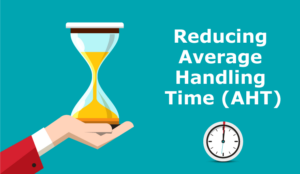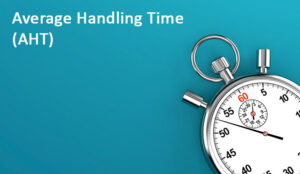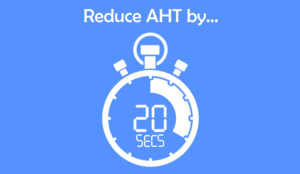We asked our panel of experts for their best advice on how call and contact centres can lower Average Handling Time (AHT) safely, and help to improve Calls Per Hour (CPH).
Improve the Employee Experience

Your call centre agents will need to be equipped with the right information at the right time.
60% of failed attempts at first call resolution are due to an agent’s inability to access the right data.
There are a few ways you can make it easier:
- You need to eliminate silos within your contact centre by integrating your CRM with your contact centre solution. This way agents have deep insight into customer history during every interaction.
- Automate repetitive tasks with virtual assistants so your human agents can focus on more complex interactions.
- Ensure your agents can reach subject-matter experts in real time to accelerate resolutions with an appropriate UC integration.
- Use robotic process automation on your agent’s desktop environment to surface the right information at the right time. This way agents do not waste time looking for valuable information whilst engaged in an interaction.
Overall, with the right contact centre agent’s tools, you can simultaneously improve every customer interaction and reduce AHT safely.
Contributed by: Geoff Donnelly at Five9
Automate After-Call Work (ACW)
Handling time consists of three parts: talk time, hold time, and wrap time.
To lower AHT without negatively influencing service quality, many contact centres choose to target each of these three pieces of the handling time pie individually.
For example, they may reduce talk time by enhancing knowledge management, implementing agent-assist technologies, and automating desktop processes, whereas to lower hold time, many will build a better routing strategy or run special coaching initiatives on tricky contact types.
Yet many operations are eliminating wrap time almost entirely with speech analytics, automating timely processes such as:
- Categorizing and logging contacts
- Summarizing call notes
- Updating information in the CRM and other systems
- Performing follow-up tasks (e.g. sending confirmation emails)
As such, agents shift from ACW creators to editors, reducing wrap time by as much as 80% and AHT by 20%
Optimize Multiskill Scheduling
Matching the right skills with the right incoming contacts is a sure-fire method of reducing AHT. Yet many aim to do this through data-driven routing alone, overlooking the significance of workforce management (WFM).
With multiskill and multi-activity configurations, WFM software maximizes operational productivity and lowers AHT while increasing planning flexibility and reducing idle time in the process.
Such capabilities are essential when brands switch to an omnichannel or multichannel strategy. Yes, Erlang can work well in single-skill environments. But that is the extent of its practicality.
As contact centres add channels and evolve, so must the WFM strategy. In small, growing operations – where the “power of one” effect is more influential – planning is tricky. Cloud WFM software helps SMEs balance efficiency with effectiveness and optimize multiskill scheduling.
Also, it enables operations to control occupancy better and guard against burnout, which negatively affects AHT and well-being.
Guard Against “Emotional Contagion”

Emotional contagion is the phenomenon where we catch the emotions of the people we talk to.
In the contact centre, where many customers are anxious, angry or upset, the effect often throws agents off-course, impacting their mood, amplifying disengagement, and increasing AHT.
While leaders often ask agents to “walk in the customer’s shoes”, such advice only facilitates these negative consequences. After all, there is a fine line between burnout and contagion.
Dr Jeffrey Gaines notes this effect in a recent Positive Psychology article. He states: “There are cases of therapists or other helping professionals feeling their clients’ distress so acutely that they become emotionally distressed themselves and can no longer function as helpers.”
Yet, the problem is not empathy in itself but how it is coached. Self-awareness must become part of the discussion, ensuring agents notice when they “catch” an emotion, think of themselves as resilient individuals, and refuse to take on board that feeling.
Develop an AHT-Focused Quality Initiative
Rushed for time, many analysts meet their quality monitoring quotas by reviewing contacts with low handling times. In doing so, they often miss significant knowledge gaps, broken processes and agent workarounds, which contribute to high AHT rates.
As a result, some quality teams choose to group together and assess the AHT outliers, uncovering teething trends that skew the metric. Running such projects for contacts with escalations, transfers, and multiple holds may also provide relevant insights.
Quality management systems allow analysts to flag these outliers while improving the ease of completing other initiatives to lower AHT, including quartile analysis.
Quartile analysis identifies agents in the top quartile for both AHT and customer satisfaction. By assessing their customer conversations, contact centres can uncover critical learnings to coach across the agent population.
Within the system, analysts may also flag examples of their best interactions to provide “real-world” guidance.
Contributed by: Graeme Meikle at Calabrio
Consider the Impact of Lowering AHT

Before a company makes lowering their AHT metric a goal, they should consider how engagement and satisfaction corresponds to AHT numbers while taking the entire customer journey into account.
For example, a company’s AHT can be high because they’ve already automated or offloaded a lot of the easy stuff.
A large trend for companies currently is to automate workflows. This means customers can get immediate responses to routine needs (such as address changes, password options or renewals) via self-service or through a website. For example, they may have delved into your FAQs or searched online forums.
Once that has been sorted, the company should ensure they have platform-wide reporting and analytics capabilities in place to help them measure their AHT.
They can then start to implement solutions that should be intuitive and with a design-led interface to streamline customer interactions.
By empowering employees with tools to simplify their daily tasks, they are more engaged, which in turn keeps productivity high and customer experiences powerful.
The bottom line is this: depending on the issue, customers expect high levels of attention and service, which means agents need to be prepared to respond.
They may have to dig for answers or find another expert to help. These things can take time, and that’s where having easy access to knowledge workers in different departments can make all the difference.
Many companies view having customers on the line as an opportunity to increase customer engagement.
In this scenario, rather than focusing only on AHT, companies evaluate whether there are correlations between longer talk times and improved metrics around areas such as customer satisfaction, first contact resolution, and higher revenue.
In the end, the goal is to increase customer engagement and happiness. So, whether it’s answering their questions quickly, or solving a complex issue completely and thoroughly, it’s key that the customer leaves the interaction with a positive experience.
Contributed by: Janice Rapp at 8×8
Don’t Try Just for the Sake of It
The most common motivator behind attempts to reduce AHT is cost efficiency. The voice channel is the most expensive per interaction and strongly associated with AHT, which is steadily increasing.
However, organizations need to think carefully about how they have informed their decision when setting targets for AHT.
Additionally, organizations need to consider what measures should be put in place to safeguard customer experiences and services while trying to reduce AHT. It may simply not be worth the trade-off and can be an easy trap to fall into, one leading to declining loyalty.
In a digital world of intense competition, few organizations can afford that. In fact, putting pressure on agents to reduce AHT in some industries, like healthcare, could even be harmful.
With the increasing complexity of issues reaching agents, AHT should also be expected to increase further so it could be argued that trying to reduce it seems both unrealistic and risky.
Train and Cross-Skill Agents

Even with expert communication skills, if agents lack the right information, customer interactions can be like stumbling around in the dark and AHT will suffer.
Onboarding, coaching and effective knowledge management mean agents know the best ways to help or have easy access to the information they need to reach resolution.
This can even empower cross-skilling, so agents can help with smaller tasks outside their skillset to reduce transfers.
This can have the happy side effect of reducing AHT. Better use of customer details can also personalize experiences and offer greater efficiency by bypassing dialogue around irrelevant promotions.
However, this process can also identify real cross-selling or upselling opportunities, which would extend handling time. With engaged and informed agents, time limits can actually inhibit peak performance.
Make Calls More Efficient
AHT can be influenced by setting the stage so calls play out in the most efficient way. Qualification and routing can make a big difference.
Advanced systems can collect information during qualification that is then available to agents, including the customer’s reason for calling phrased in their own words. Routing optimally matches agents to incoming queries, increasing the chance of First Contact Resolution (FCR) and a lower AHT.
However, these systems also direct some customers to automated services, helping them bypass call queues. Although the system becomes optimized for FCR, the increasing proportion of simpler queries which are redirected may mean that AHT continues to rise.
The benefits to AHT by leveraging technology can therefore be masked by an overall upward trend.
Remember that average is just that, and many calls will be either much shorter highly efficient interactions, or much longer high-complexity added-value interactions.
Contributed by: Richard Gregory at Odigo
Use Pre-Call Validation and Post-Call Messaging

There are two easy-to-implement methods you can roll out to safely lower average handling time (AHT) without impacting service levels.
Pre-call validation and messaging is the first; ensuring you utilize interactive voice response (IVR) systems to carry out identification and data protection act (DPA) checks.
Post-call messaging, where a customer is transferred to an IVR to play T&Cs, for example; just don’t forget to give the customer an easy way to get back to the advisor if they do have any questions.
Contributed by: Drew Naylor at MaxContact
Personalize the Customer Experience

A great way to lower average handling time (AHT) is to personalize the customer experience.
Consider introducing computer telephony integration (CTI) to facilitate this. CTI systems enable integration of phone systems with customer relationship management (CRM) applications.
Where customers call in, a CTI platform stores data from the call, and prompts a ticket in the CRM system.
With quick access to the caller’s contact information such as customer’s name, reason for calling and service history, CTI systems increase efficiency and provide a better more personalized customer experience.
Alongside this, consider consistently tagging caller intention to help drive customer personalization and lower average handling time.
Where customers make repeat calls, recording caller intention such as ‘complaint’ or ‘renewal’ can help agents identify at which stage of the customer journey callers may be. With relevant, real-time information, agents can then tailor interactions depending on caller history and intent.
Contributed by: Hamish Cliff at Business Systems
Make It Easy for Agents to Find the Information

The safest way to lower AHT is to reduce the time agents spend navigating between multiple tools, systems, and processes as they seek to resolve customer queries.
Doing so reduces frustration on both sides; agents can spend time addressing the issue at hand not finding the data, while the customer feels listened to.
The solution is a quartet of robotic process automation (RPA), attended automation and artificial intelligence (AI) and advanced analytics.
RPA desktop robots can automate after-call work such as capturing customer call notes and customer data. Attended automation assistants help agents get the information they need by pulling data from legacy systems and providing convenient summaries to agents in real time.
Machine learning models and advanced analytics provide insights that help agents to offer better and more personalized advice and service – for instance, an analysis of the customer’s potential pain points and product recommendations that address their needs.
By using AI to provide customer insights on desktops, agents can then be guided through compliance steps. This encourages agents to deliver a stronger and more elevated experience. Providing a next-best action step can not only keep AHT down and ensure optimal service from the agent.
Contributed by: Karen Inbar at NICE
Harness Better Analytics

For the most part, AHT is impacted by process inefficiencies. Starting by analysing workflows and basic customer data might be key to driving down your AHT.
With more insightful contact centre analytics, businesses can delve deeper into their call-handling performance, and access data across different customer touchpoints and channels.
In terms of call data, you’ll be able to see how much time agents spend actively speaking, how long customers are put on hold for, and how long it takes to reach an agent.
This means you’ll be better placed to identify the root cause of any obvious inefficiencies from the off, and your agents will have all the customer information they need at their fingertips.
Open Internal Communication Channels
Sometimes agents just need a helping hand, especially when they’re new to the team, or in training.
With the right collaborative culture and appropriate communications platforms in place, simply communicating more can help teams to lower their AHT without sacrificing customer satisfaction.
If there’s a particularly complex or niche customer query, it’s important to make sure agents can tap into the knowledge of specialists and experts to help them resolve issues faster.
Likewise, simply being able to fire off a message to a colleague during a live call means customers don’t have to get passed from one agent to another (which is often a real source of frustration).
Being able to reach out to fellow team members quickly during any customer interaction means agents don’t feel they have to work in isolation and can solve queries as a team whenever necessary.
Use IVR Systems and Automate FAQs
Making use of automation and self-service elements for customers can help to significantly drive down your AHT.
Today’s customers want the most convenient solution to their customer service query, and in recent years customer expectations in terms of speed of resolution have skyrocketed.
So, making use of automated responses to simple, and frequently asked questions can hugely enhance your service experience by allowing customers to quickly resolve their issues without needing to speak with an agent.
Likewise, with IVR (interactive voice response), you can send customers directly to the agent or department that best meets their needs.
That means your agents won’t have to struggle with questions that aren’t in their remit, and for customers, interaction will be more targeted, and queries will be resolved quicker.
Contributed by: Louise Newbury-Smith at RingCentral
Give Agent Consistent Coaching and Real-Time Guidance

Average handle time can be a misleading call centre KPI. While a reduced AHT can cut an organization’s operating costs, this benefit can come with a cost of its own. Rushing customers off the phone or failing to resolve their problems leads to customer dissatisfaction and churn.
Organizations can reduce AHT organically by improving agent performance through continual coaching, helping them assist customers faster and more effectively. Consistent coaching combined with real-time guidance can also drive better first call resolution rates and customer satisfaction.
- Do agents have easy access to the knowledge base they need?
- Are customers sent to the right agent to limit hold times and transfers?
- Can administrative tasks be automated?
These best practices are vital to ensuring successful, concise interactions with customers. It’s also vital to analyse every channel of customer contact to discover and eliminate patterns of inefficiency.
Contributed by: Frank Sherlock at CallMiner
Teach Agents to Identify the Root Cause of an Issue
Lower average handling times (AHT) are sought after by many contact centres and companies. It is crucial to provide your team members with the tools they need to be as efficient as possible.
Your agents must know how to identify the root source of an issue rapidly and how they can handle it.
The better your agents are at analysing the situation, the more equipped they’ll be to take the proper steps, from transferring a call to a supervisor, to delivering a speedy resolution.
Contributed by: Geomant
Create a Digital Workspace for Virtual Colleagues

Many organizations have seen an increase in AHT over the last two years as a result of transitioning to work-from-home (WFH) during lockdown.
In a bricks and mortar (B&M) environment, if an advisor needs help they usually attract the attention of their manager or call on advice from a colleague.
But for many businesses attempting WFH for the first time, such simple team communications and management have proven tricky – with the situation often exacerbated by poor knowledge sharing amongst WFH personnel and disengagement when it comes to sharing ideas for change.
The answer is to give WFH personnel more of the things that they are used to in the B&M world when it comes to employee management, employee–employee and corporate communications – and a digital workplace can facilitate that.
Think of a WFH advisor with two screens on their desktop – one a CRM or ‘work’ screen, and the other their communications/management environment.
Through that second screen they keep in touch with colleagues, managers and support teams (HR, IT, Quality etc.), receive support, get team and company updates, share information, and even socialize.
It’s a fresh way of looking at communications/management in the WFH world, and it’s one that is proven in its ability to address WFH concerns.
For one major UK insurer it has not only reduced AHT, but also given its WFH consultants greater visibility of each other, easier access to support, helped promote shared learning, and improved employee experience scores.
Contributed by: Simon Hunter, Chief Commercial Officer (CCO) at Sensée
Look at Training and System Integration
Shaving seconds off customer interactions can translate to huge efficiency gains and operational savings.
However, most organizations have reaped the low-hanging fruit with AHT. They have mastered interactive voice response (IVR), trained agents on using scripts to speed problem resolution, and deployed chatbots to automate Q&A sessions.
So, what’s left?
Given that businesses are transforming constantly, it’s always worth revisiting product training, to ensure that agents are up to date on new solutions.
Technology systems with customer data should be fully integrated to provide a holistic view of interactions.
And customer experience teams should review interaction data to see if there are opportunities for strengthening self-service tools, such as knowledge bases and chatbots.
In addition, organizations that commit to automated customer experience (CX) testing can proactively identify issues before they harm consumers, protecting AHT.
Monitor and Assess Channel Growth
Most contact centres support at least nine channels:
- Interactive voice response (IVR)
- Telephone calls
- Webchat
- Social media
- Self-service
- Letters
- Faxes
- Texts
The list is constantly growing. However, the more channels they use, the greater the risk of gaps and flaws.
Self-service tool failures make agents work to obtain information they’d normally be given. Similarly, poor voice quality on calls can increase their length. All of these issues add to AHT.
Organizations can use automated customer experience (CX) testing to evaluate channels before they deploy them, understanding how they function in isolation as well as interact with others.
Equally importantly, proactive and ongoing testing enables organizations to model the impact of tool and process changes before they are rolled out to large customer bases. As a result, automated CX testing can be a valuable resource in the ongoing battle to reduce AHT.
Have a Plan to Get Systems Back up and Running
With 75 percent of contact centres operating cloud-first or in a hybrid mode, ensuring seamless technology integration and system uptime is more essential than ever.
If self-service tools or other channels fail, consumers turn to the phone, increasing call volumes, swamping agents with work, and increasing average handling time (AHT).
So, it’s no surprise that when severe incidents occur, they get IT’s attention. Organizations that use customer experience (CX) assurance platforms can integrate this data with IT service management (ITSM) systems, streamlining ticketing and support, facilitating a rapid response, and reducing mean time to repair.
Contributed by: Holly Larson at Cyara
Monitor Trends and Ask for Feedback

Companies attuned to market changes, localized economic events and industry trends can apply these metrics to predict account actions within segments.
Assessing the impact of more volatile trends and events will help inform and predict key shifts and trigger forecast and staffing response.
Companies that want to stay ahead of market trends will commit to almost continuous reforecasting and retooling call centre metrics in order to react to changing conditions.
Connect AHT to Supplemental Metrics
Handle time means nothing if the CX, ACW or Net Promoter Score (NPS) suffer as well. Resolution is worth far more to the customer than your handle time.
Connecting an internal measurement such as average handle time to an external metric like first call resolution will help to paint a more accurate picture of overall customer experience and journey.
Keep related metrics in mind when staffing and training; in addition to telling a story, your agents can better understand the business objectives when multiple metrics can connect the dots.
Contributed by: Kaye Rickards at Alvaria
Automate or Remove Aspects That Take Unnecessary Time

There can be risks associated with reducing average handling time (AHT) as it can put pressure on agents, reduce first call resolution rates and increase frustration.
However, automating or removing those things that take up unnecessary time is key to reducing AHT.
If the customer is waiting in silence or on hold, those are your golden opportunities to reduce AHT. It’s the same with standard scripted events or required declarations – Direct Debit Guarantee is a classic.
Contributed by: Sean McIver at MaxContact
Combine AHT with CX
You should evaluate AHT in line with CX. One way to do this would be to tie end-of-call surveys directly to the call’s AHT. This will allow for the creation of an AHT to CX rating.
This could be done by creating a grouping for AHT, ie 0-5minutes = 1; 5-20 minutes = 2 etc.
The AHT grouping of the call would then be saved alongside the customer’s rating. By allocating a median average of customer rating vs. AHT group, you will get a good idea of what the optimal AHT is for your specific circumstance. You can then work on bringing that down if need be.
Reward Agents With the Lowest Median AHT and Highest CX

Utilizing an AHT to CX formula as above would allow you to reward agents that have low AHT but still maintain the customer experience.
These are the agents you should reward. This will create a culture where the customer experience is the key factor but AHT is still an aim.
Review Recordings
Review recordings that detail the lowest AHT and highest CX. If applicable, incorporate the recordings into a training guide for new staff.
Highlighting a few low AHT and high CX recordings for the month that go out to all staff at the end of the month will also help create a culture of continual evaluation and improvement.
Contributed by: Caroline Leonard at Spearline
For more great insights and advice from our panel of experts, read these articles next:
- How Often Should You Seek Customer Feedback?
- The Best Metrics for Contact Centre Performance Tracking
- How to Improve Customer Satisfaction
- Top Tips to Monitor Customer Service
Author: Robyn Coppell
Reviewed by: Rachael Trickey
Published On: 29th Aug 2022 - Last modified: 6th Jan 2026
Read more about - Call Centre Management, 8x8, Alvaria, Average Handling Time (AHT), Business Systems, Calabrio, Call Handling, CallMiner, Caroline Leonard, Customer Service, Cyara, Drew Naylor, Five9, Frank Sherlock, Geoff Donnelly, Geomant, Graeme Meikle, Management Strategies, MaxContact, Metrics, NiCE, Odigo, Richard Gregory, RingCentral, Sean McIver, Sensee, Simon Hunter, Spearline





















